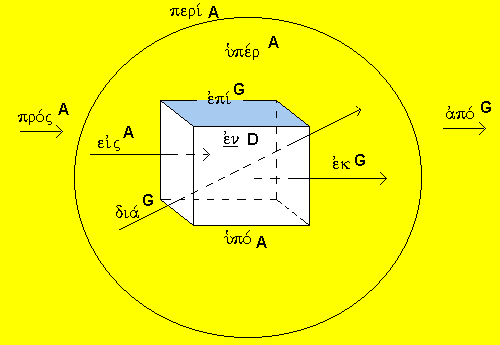Lesson 9 – Prepositions, Compound Verbs, ὅτι
Prepositions
In English, prepositions are words like in, over, from, etc.
A preposition introduces a prepositional phrase. In the following examples, The highlighted phrases are the prepositional phrases.
He was sitting on the chair.
The man in the car is the driver.
In each prepositional phrase, there is an object of the preposition. In the first example, chair is the object of the preposition on. In the second example, car is the object of the preposition in.
In Greek, it is very important to learn what cases can be used with a given preposition, and to note what meaning is associated with the preposition for each case. Some prepositions consistently take only one case. Other prepositions may take two or three different cases, and have varying meanings depending on which case is used. You must associate the case and the meaning together when learning a preposition. For example, you should not be content to learn that ἐνmeans in. Rather you must learn that ἐν used with the dative case means in.
In Jn. 17:13, notice that κόσμῳ, the object of the preposition ἐν, is in the dative case:
I speak these things ἐν τῷ κόσμῳ
And of course, τῷ is dative because it must agree with the noun it modifies.
Learn the following prepositions, associating each case used with the corresponding meaning.
| ἀπό | gen. | from | apostasy – a falling away from |
| ἄχρι | gen. | until, as far as | |
| διά | acc. gen. | on account of though | diameter – measure through |
| εἰς | acc. | unto, into | |
| ἐκ, ἐξ preceding a vowel | gen. | out of | exit |
| ἐν | dat. | in | |
| ἐνώπιον | gen. | before | |
| ἔξω | gen. | outside [of] | exoskeleton – skeleton on the outside |
| ἕως | gen. | as far as, until | |
| κατά | acc. gen. | according to against, down from | |
| μετά | acc. gen. | after with | metamorphosis – after form |
| περί | acc. gen. | around concerning | perimeter – measure around |
| πρό | gen. | before | program – written before |
| πρός | acc. | to, toward | proselyte – one who comes to another religion |
| σύν | dat. | with | |
| ὑπέρ | acc. gen. | over, above on behalf of | hyperactive – over active |
| ὑπό | acc. gen. | under by | hypodermic – under the skin |
Many prepositions can be thought of geometrically, or spatially. Consider the prepositions represented in the graphic below, noting carefully the case with which the indicated meaning is associated.

This is an adaptation and simplification of a geometric representation of prepositions found on p. 80 in Lexical Aids for Students of New Testament Greek, by Bruce M. Metzger, 1977
Compound Verbs
Compounds of a preposition and a verb
Prepositions are often combined with verbs to form compound words. The effect of the preposition on the meaning of the verb varies, but we can loosely categorize most of these effects as follows:
- The meaning of the preposition is combined with the meaning of the verb.
For example βαίνω means I go. Remember that κατά can mean down. Accordingly, καταβαίνω means I go down. - The meaning of the verb is intensified. Compounds intensified by a prefixed preposition are sometimes called “perfectives” because the action is viewed as carried out to perfection, i.e. to completion. For example, ἐσθίωmeans eat, but when κατά is prefixed to form κατεσθίω, the meaning is devour (See κατεσθίω used in Mk. 12:40.) Here, perhaps we see something reminiscent of an English idiom that makes the Greek seem less strange. If we talk about some one devouring his food, we may say he eats it up.
- The meaning of the verb is unaffected. καλύπτω is cover. In a number of passages in the Septuagint (a Greek translation of the Old Testament scriptures), κατακαλύπτω means cover and is hardly, if at all, to be distinguished from καλύπτω.
Prepositions ending in vowels
Notice that the final vowel of κατά is dropped when the preposition is prefixed to ἐσθίω. The compound isκατεσθίω, not καταεσθίω. This will happen any time a preposition with a final vowel is prefixed to a verb beginning with a vowel, except in the cases of περί (for example, περί + αἰρέω = περιαιρέω) and πρό (for example, πρό +ἄγω = προάγω).
Repetition of the preposition
Often when a preposition is expressed as part of a compound verb, it is repeated in its own right.
ἐκβάλλει ἐκ τοῦ θησαυροῦ αὐτοῦ Mt. 13:52
He brings out of his treasure
ὅτι
Be aware of three uses of ὅτι. See pages 74-76 in your text book (pages 51-52 in the first edition) where there is a good discussion of these.
- to introduce cause, meaning because
- to introduce an object clause
- to introduce discourse, both direct and indirect
